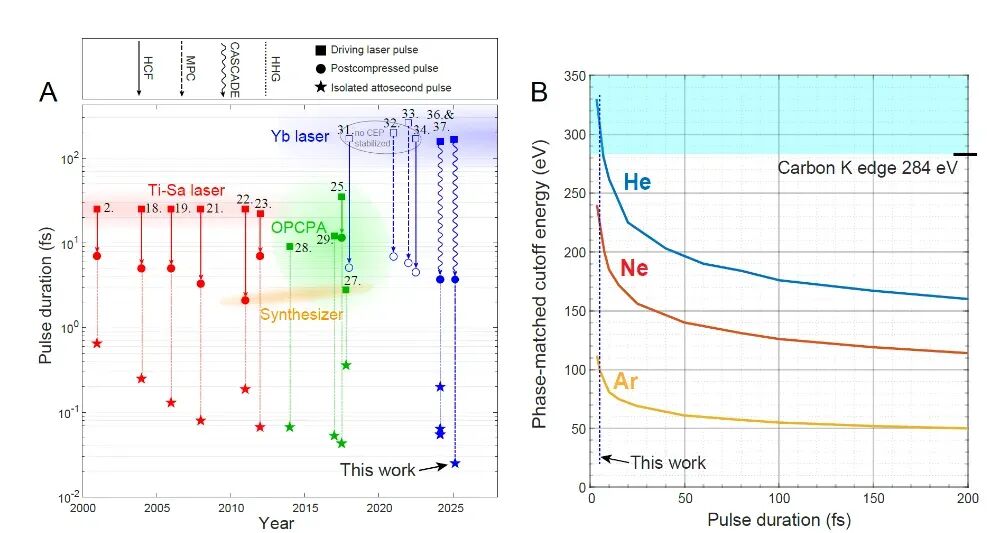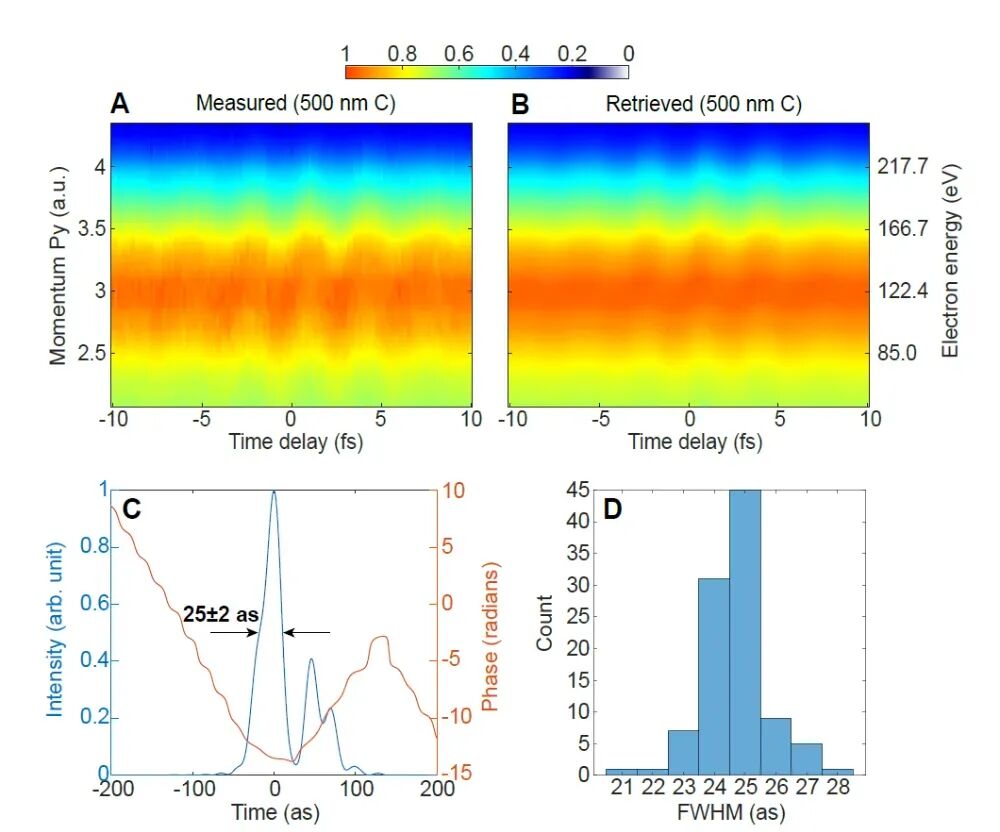The Eightieth in the Realm of Ultrafast Nonlinear Optical Techniques: High-Throughput Generation of 25-Attosecond Pulses
![]() 11/17 2025
11/17 2025
![]() 343
343
The attosecond pulse, which lasts for 10-18 seconds, stands as the shortest time-scale tool mastered by humankind. It enables the direct observation and control of ultrafast electron dynamics within atoms. Since the year 2000, the development of attosecond pulses has progressed through three distinct stages (as shown in Figure 1). During the first decade, titanium-sapphire femtosecond lasers, with a central wavelength of 800 nm, were predominantly employed. These lasers generated 4–5 fs driving pulses through hollow-core fiber compression. Subsequently, high-order harmonic generation (HHG) was utilized to produce isolated attosecond pulses. However, constrained by the driving spectrum and phase-matching conditions, these pulses typically exhibited photon energies below 150 eV and pulse widths around 60 as. To further shorten the pulse width, it became necessary to expand the coverage of the harmonic spectrum.
After 2010, researchers shifted to using mid-infrared (~1.8 μm) optical parametric amplification systems as the driving source for HHG. This innovation extended the high-order harmonics into the soft X-ray 'water window' region and pushed the pulse width record to 40–50 as. In this particular study, the research team harnessed a sub-5 fs 1030 nm driving light source. This effectively suppressed phase mismatch caused by ionization, enhanced the cutoff energy of HHG, and ultimately achieved the current shortest pulse record of 25 as [1].

Figure 1 Development Timeline of Attosecond Pulses [1]
The system is illustrated in Figure 2. It utilizes a ytterbium-doped femtosecond laser device with a central wavelength of 1030 nm. After compression, this device generates driving pulses of 3.7 fs and 1 mJ. The beam is then split by a beam splitter into an outer strong pulse (for HHG) and an inner weak pulse (for characterization). The inner pulse is precisely adjusted using an electrically controlled delay mirror. Subsequently, it is co-focused with the outer pulse by a silver mirror into a helium gas cell to generate attosecond pulses. Afterward, a pinhole filters out residual infrared light, allowing only XUV and central infrared light to pass through. A fused silica filter with a central aperture is then employed to compensate for the delay of the inner pulse. Meanwhile, replaceable metal thin-film filters truncate low-energy XUV components and compensate for attosecond chirp. Finally, the two beams are focused by a parabolic mirror into the detection area for synchronized measurement.

Figure 2 System Schematic Diagram [1]
In XUV attosecond pulse experiments, metal filters are employed to truncate low-energy components in the continuous spectrum. This study conducted a comparative analysis of four types of filters (as depicted in Figure 3). The tin film has a transmission threshold above 120 eV, truncating high-energy components above 150 eV. The zirconium film (60–150 eV) introduces reverse group delay dispersion along its transmission edge, which affects pulse quality. The aluminum film transmits below 73 eV and above 200 eV, a range that does not match the experimental spectrum. Ultimately, the carbon film was chosen. It has a transmission range covering 50–280 eV, encompassing most of the XUV spectrum in this experiment. It truncates fewer high-energy components and has a minimal dispersion impact, thus better meeting the experimental requirements. The transform-limited pulse width of the spectrum after carbon film filtering is 11.4 as (as shown in Figure 3F).

Figure 3 Comparison of Four Filters [1]
During the experiment, the rising edge of the carbon film's transmission spectrum provided negative group delay dispersion (GDD), with each 200 nm of thickness contributing -400 as2 GDD. By systematically adjusting the carbon film thickness (ranging from 200–600 nm), changes in the symmetry of photoelectron streaks were observed to control the chirp (as shown in Figure 4). Without a filter, the streaks were tilted, indicating positive chirp. As the thickness increased, the streaks became more symmetric, approaching complete symmetry at 500 nm. This reflected effective compensation of attosecond chirp and a pulse close to the transform limit. When the thickness increased to 600 nm, the streaks tilted in the opposite direction, indicating negative chirp introduced by over-compensation. Ultimately, by optimizing the thickness, the pulse was successfully compressed to 25 as.

Figure 4 Attosecond Pulse Recovery [1]
This study effectively enhanced the HHG cutoff energy by utilizing a millijoule-level few-cycle ytterbium-doped light source. It successfully obtained 25 as attosecond pulses with a photon flux exceeding 1012 per second. The combination of this high-throughput output with a stable online angle-resolved attosecond streak camera has unlocked new experimental capabilities, paving the way for extensive research at the intrinsic time scales of electrons and ions.
References: [1] Gao J, Hasan M, Liang H, et al. Bright 25-attosecond light pulses reach the one atomic unit of time[J]. arXiv preprint arXiv:2508.14774, 2025.






